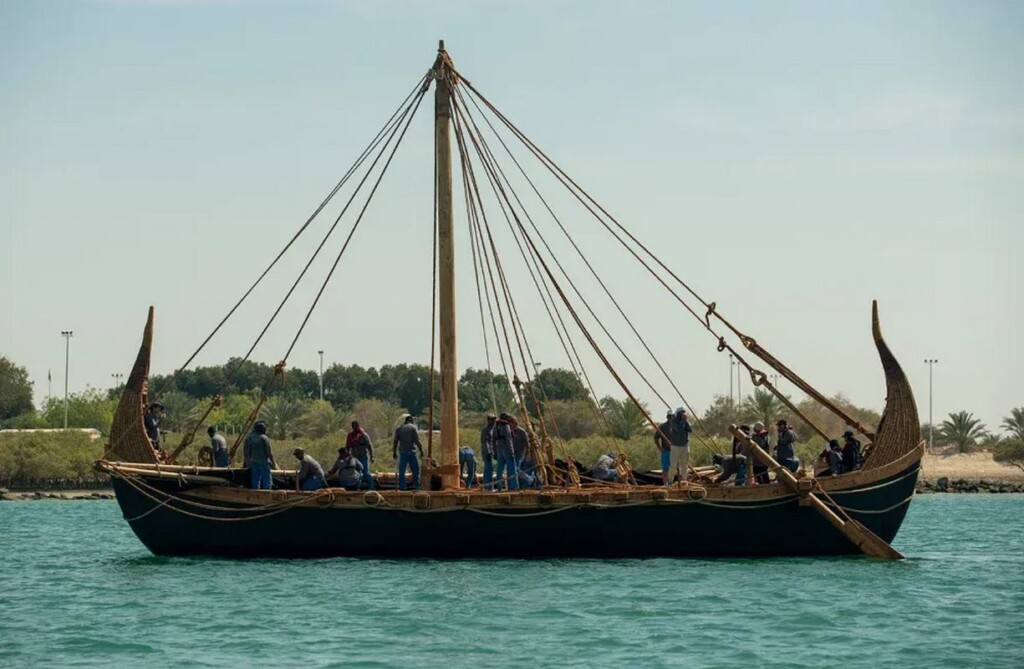 Photo by Emily Harris, Zayed National Museum – released
Photo by Emily Harris, Zayed National Museum – releasedA 59-foot-long reproduction of an ancient Near Eastern trading vessel has successfully sailed off the coast of Abu Dhabi.
The vessel, called a ‘Magan Boat’ in ancient times after the name of the area encompassing the UAE and parts of Oman today, was built with raw materials described on an ancient clay tablet and using techniques dating back to 2,100 BCE.
The shape of the vessel was based on ancient illustrations of boats and the reconstruction was based on a capacity of 120 Gur, a Bronze Age semi-standard weight equivalent to 36 tons today. The length, width, and depth were determined by a naval engineer using hydrostatic analysis to provide dimensions that would enable the boat to float once the estimated weight of cargo, boat, and crew were added.
The ‘Magan Boat’ project is an experimental archaeology initiative from the Zayed National Museum in partnership with Zayed University and New York University Abu Dhabi (NYU Abu Dhabi). Launched in 2021, the project aims to deepen understanding of how people in the region lived over 4,000 years ago, as well as preserve the UAE’s maritime heritage and traditional crafts.
The historians, archaeologists, and anthropologists involved in the project hypothesize that, since during the Bronze Age the craft were referred to as Magan boats, it must therefore reflect that the ancient forbearers of today’s state of UAE were famous for their role in maritime trade. Ships of this size and strength allowed people living in the UAE to trade with communities as far away as Mesopotamia (modern-day Iraq) and South Asia.
“It has been a long and exciting journey from discovering ancient fragments of Magan boats on Umm an-Nar to the iconic moment the boat’s goat hair sail was raised and she set sail from Khor Laffan towards the open sea,” said Dr. Peter Magee, Director of Zayed National Museum.
The boat was designed by a team of over 20 specialists, including engineers and archaeologists, who seek to uncover knowledge about the past by experimenting with ancient technology using traditional techniques.
Shipwrights specializing in historical replicas worked closely with the researchers to build the boat using raw materials and traditional hand tools. The outer hull of the boat was made from 15 tons of locally sourced reeds that were soaked, stripped of their leaves, crushed, and tied into long bundles using date palm fiber rope. These were some of the objects listed on the tablet in the Sumerian language, found in the archaeological site of Tello, that detail how Magan boats were made.
MORE STORIES LIKE THIS: Why Are So Many Old Maps Covered in Sea Monsters? Nat. Geo Dives Deep
The reed bundles were lashed to an internal structure of wood frames and coated in bitumen—a waterproofing technique used by ancient shipmakers in this region. Archaeologists have recently discovered similar examples of bitumen on the island of Umm an-Nar, referred to by Dr. Magee, which match sources from Mesopotamia.
The boat passed several rigorous tests and covered a distance of 50 nautical miles (92.6km) in the Arabian Gulf. Captained by Emirati sailors and accompanied by the UAE Coastguard, the ship passed two days of sea trials, reaching speeds of up to 5.6 knots (6.4 miles per hour) under a sail made of goat hair. A crew of more than 20 people was needed to lift the sail and rigging as pulleys did not exist in the Bronze Age.
Champion Emirati sailor Marwan Abdullah Al-Marzouqi, who comes from a family whose links with the maritime heritage of the UAE go back generations, according to a release from Zayed University, was one of two captains who skippered the Magan Boat during its two days of sea trials.
MORE LIVING ARCHAEOLOGY: Egyptians Performed Brain Surgery 4,000 years ago: A Discovery Called a ‘Milestone in the History of Medicine’
“When we first towed the boat out from the jetty, we were very careful. I was very aware it was made from only reeds, ropes, and wood—there are no nails, no screws, no metal at all—and I was afraid of damaging her. But as we got underway, I soon realized that this was a strong boat. I was surprised by how this big boat, weighed down with a heavy ballast, moved so smoothly on the sea,” he said.
“Appreciating the maritime history of the Arabian Gulf is key to understanding the importance of Abu Dhabi in the ancient world,” said HE Mohamed Khalifa Al Mubarak, Chairman of the Department of Culture and Tourism of Abu Dhabi. “It is an excellent example of Abu Dhabi’s educational institutions coming together to deepen our knowledge of the past and bring history to life for everyone to learn from and enjoy.”
Source link

